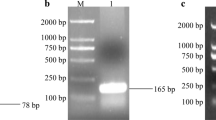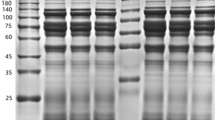Abstract
The major components of protein extracts from the cattle tick Boophilus microplus eggs and larvae of various ages were characterized by molecular sieving chromatography, ion exchange chromatography and SDS-PAGE. The fractions analysed showed a changing chromatographic pattern development. A serum raised against the components of a fraction showing characteristics of vitellin strongly reacted in Western blots with the major peptides of extracts from eggs, larvae, gut and ovary. Comparison of patterns obtained by electrophoresis in non-denaturing PAGE, stained with Coomassie blue or with benzidine/hydrogen peroxide, revealed that the major proteins of these extracts are haemoproteins, possibly in different aggregation states or heterogeneous in composition.
Similar content being viewed by others
References
Aft, R.L. and Mueller, G.C. 1983. Hemin-mediated DNA strand scission. J. Biol. Chem. 258: 12069–12072.
Aft, R.L. and Mueller, G.C. 1984. Hemin-mediated oxidative degradation of proteins. J. Biol Chem. 259: 301–305.
Araman, S.F. 1979. Protein digestion and synthesis in ixodid females. In Recent advances in acarology, 1, J.G.R.Rodriguez (ed.), pp. 385–395. Academic Press, New York.
Brown, J.B., Shapiro, S.Z. and Askenase, P.W. 1984. Characterization of tick antigens inducing host immune resistance. I. Immunization of guinea pigs with Amblyomma americanum-derived salivary gland extracts and identification of an important salivary gland protein antigen with guinea pig anti-tick antibodies. J. Immunol. 133: 3319–3325.
Burnette, W.N. 1981. Western blotting: electrophoretic transfer of proteins from sodium dodecyl sulfate polyacrylamide gels to unmodified nitrocellulose and radiographic detection with antibody and radiodinated protein A. Analyt. Biochem. 112: 195–203.
Chinzei, Y. 1983 Quantitative changes to vitellogenin and vitellin in adult female ticks, Ornithodoros moubata, during vitelogenesis. Mie med. J. 32 (3): 117–127.
Chinzei, Y. and Minoura, H. 1988. Reduced oviposition in Ornithodoros moubata (Acari: Argasidae) fed on tick-sensitized and vitellin-immunized rabbits. J. Med. Entomol. 25 (1): 26–31.
Chinzei, Y. and Yano, I. 1985a. Vitellin is the nutrient reserve during starvation in the nymphal stage of a tick. Experientia 41: 948–950.
Chinzei, Y. and Yano, I. 1985b. Far body is the site of vitellogenin synthesis in the soft tick, Ornithodoros moubata. J. Comp. Physiol. B 155: 671–678.
Chinzei, Y., Chino, H. And Takahashi, K. 1983. Purification and properties of vitellogenin and vitellin from a tick, Ornithodoros moubata. J. Comp. Physiol. 152: 13–21.
Coons, L.B., Tarnowski, B. and Ourth, D.D. 1989. Rhipicephalus sanguineus: localization of vitellogenin synthesis by immunological methods and electron microscopy. Exp. Parasitol. 54: 331–339.
Dansa-Petretski, M., Riberio, J.M.C., Atella, G.C., Masuda, H. and Oliveira, P.L. 1985. Antioxidant role of Rhodnius prolixus heme-binding protein: Protection against heme-induced lipid peroxidation. J. Biol. Chem. 270: 10893–10896.
DelPino, J.C., Trindade, V.M.T., Guma, F. and Bernard, E.A. 1989 Biochemical Studies of ovary glycoproteins of the cattle tick Boophilus microplus. Insert Biochem. 19(7): 657–661.
Dhadialla, T.S., Mango, C.K., Mongi, A.O. and Vundla, R.M.W. 1985. Antigenic glycolipoproteins isolable from the egg homogenate of fully fed female tick Rhipicephalus appendiculatus Neumann are useful in immunizing livestock and other hosts for the control of the tick in the field. In: UK Patent Application, The Patent Office, London.
Diehl, P.A., Aeshlimann, A. and Obenschain, F.D. 1982. Tick reproduction: oogenesis and oviposition. In Physiology of ticks, F.D.Obenchain and R.Galun (eds), pp. 277–350. Pergamon, Oxford.
Dunn, S.D. 1986. Effects of the modification of transfer buffer composition and the renaturation of proteins in gels on the recognition of proteins on Western blots by monoclonal antibodies. Analyt. Biochem. 157: 144–153.
Harlow, E. and Lane, D. 1988. Immunoassay. In Antibodies: A laboratory manual, E.Harlow and D.Lane (eds), pp. 553–612 Cold Spring Harbor Laboratory Press, New York.
Johnston, L.A.Y., Kemp, D.H. and Pearson, R.D. 1986. Immunization of cattle against Boophilus microplus using extracts derived from adult female ticks: effects of induced immunity on tick populations. Int. J. Parasitol. 16 (1): 27–34.
Johnstone, A. and Thorpe, R. 1982. Immunoassays. In Immunochemistry in practice. A.Johnstone and R.Thorpe (eds), pp. 233–255. Blackwell Scientific Publications, London.
Kamel, M.Y., Shalady, F.Y. and Ghazy, A.E.M. 1982. Biochemical studies of tick embryogenesis DNA, RNA, haemoprotein, guanosine and guanine in developing eggs of Hyaloma dromedarii. Insect Biochem. 12: 15–23.
Laemmli, E.K. 1970. Cleavage of structural proteins during the assembly of the head of bacteriophage T4. Nature 227: 680–685.
Muller-Eberhard, U. and Morgan, W.T. 1975. Porphyrin-binding proteins in serum. Ann. NY Acad. Sci. 224: 624–650.
Opdebeeck, J.P., Wong, J.Y.M. and Dobson, C. 1989. Hereford cattle protected against Boophilus microplus with antigens purified by immunoaffinity chromatography from larval and adult ticks. Immunology 67: 388–393.
Rand, K.N., Moore, T., Sriskantha, A., Spring, K. Tellam, R., Willadsen, P. and Cobon, G.S. 1989. Cloning and expression of a protective antigen from the cattle tick Boorphilus microplus. Proc. Natl. Acad. Sci. USA 86: 9657–9661.
Rosell-Davis, R. and Coons, L.B. 1989. Relationship between feeding, mating, vitellogenin production and vitellogenesis in the tick Dermacentor variabilis. Exp. Appl. Acarol. 7: 95–105.
Rosell, R. and Coons, L.B. 1990. Quantification of vitellogenin in the hemolymph and localization of vitellogenin in selected organs of adult female Dermacentor variabilis. In Advances in Invertebrate Reproduction. M.Hoshi and O.Yamashita (eds), pp. 559–564. Elsevier, Amsterdam.
Rosell, R. and Coons, L.B. 1991. Purification and partial characterization of vitellin from the eggs of the hard tick. Dermacentor variabilis. Insect Biochem. 21 (8): 871–885.
Rosell, R. and Coons, L.B. 1992. The role of the fat body, midgut and ovary in the vitellogenin production and vitellogenesis in the female tick. Dermacentor variabilis. Int. J. Parasitol. 22 (3): 341–349.
Tappel, A.L. 1955. Unsaturated lipid oxidation catalysed by hematin compounds. J. Biol. Chem. 217: 721–733.
Thomas, P., Ryan, D. and Levin, W. 1976. An improved staining procedure for the detection of the peroxidase activity of cytochrome P-450 on sodium dodecyl sulfate polyacrylamide gels. Analyt. Biochem. 75: 158–168.
Towbin, A.S., Staehelin, T. and Gordon, J. 1979. Electrophoretic transfer of proteins from polyacrylamide gels to nitocellulose sheets: procedure and some applications. Proc. Natl. Acad. Sci. USA 76: 4350–4354.
Turnbull, J.F., Smith, D.R.J., Sharp, P.J., Cobon, G.S. and Hynes, M.J. 1990. Expression and secretion in Aspergillus nidulons and Aspergillus niger of a cell surface glycoprotein from the cattle tick, Boophilus microplus, by using the fungal amdS promoter system. Appl. Environ. Microbiol. 56 (9): 2847–2852.
Willadsen, P., Riding, G.A., Mckenna, R.V., Kemp, D.H., Tellam, R.L., Nielsen, J.N., Lahnstein, J., Cobon, G.S. and Gouch, J.M. 1989. Immunological control of a parasitic arthropod. Identification of a protective antigen from Boophilus microplus. J. Immunol. 143 (4): 1346–1351.
Author information
Authors and Affiliations
Rights and permissions
About this article
Cite this article
Canal, C.W., Maia, H.M., Vaz Junior, I.S. et al. Changing patterns of vitellin-related peptides during development of the cattle tick Boophilus microplus . Exp Appl Acarol 19, 325–336 (1995). https://doi.org/10.1007/BF00052390
Issue Date:
DOI: https://doi.org/10.1007/BF00052390




